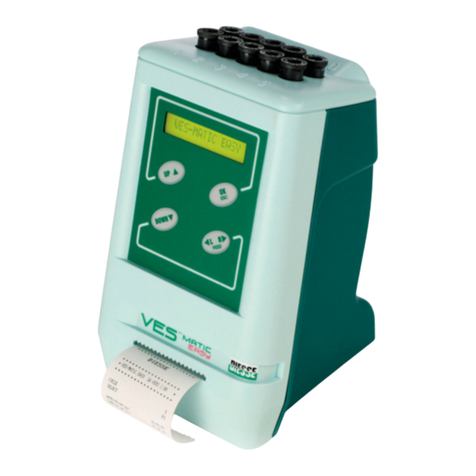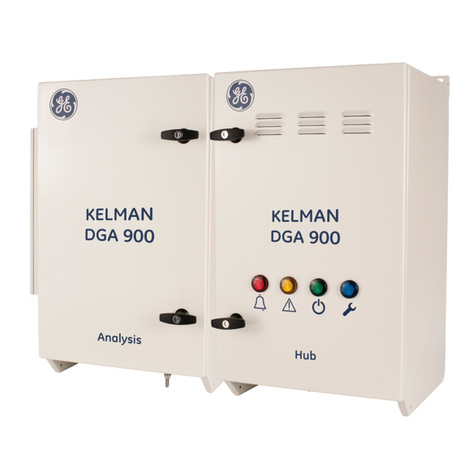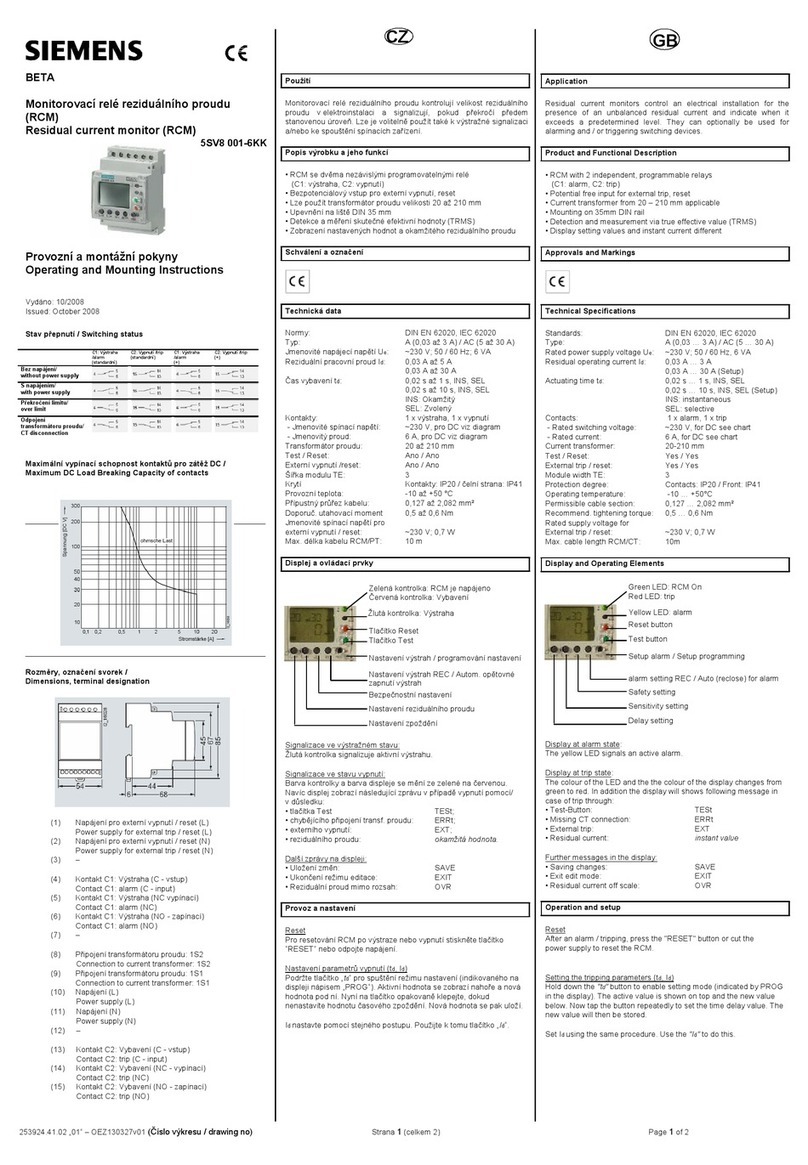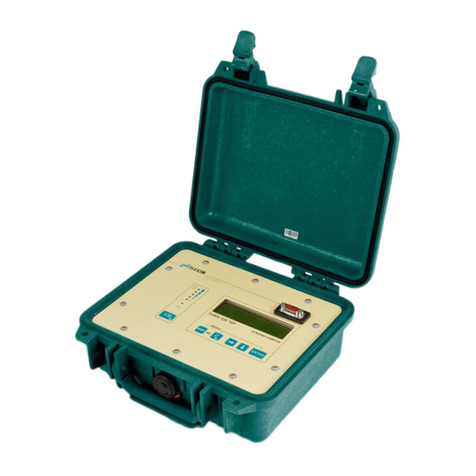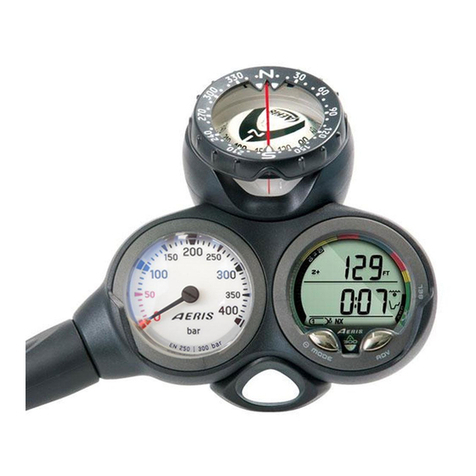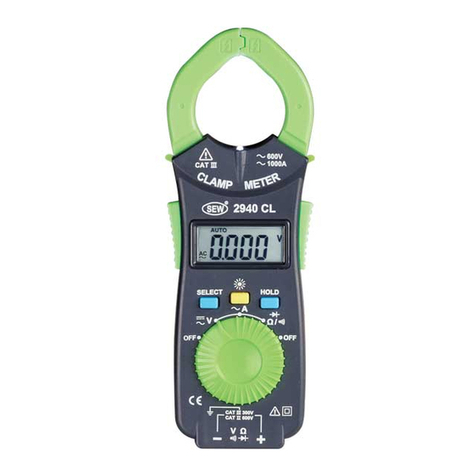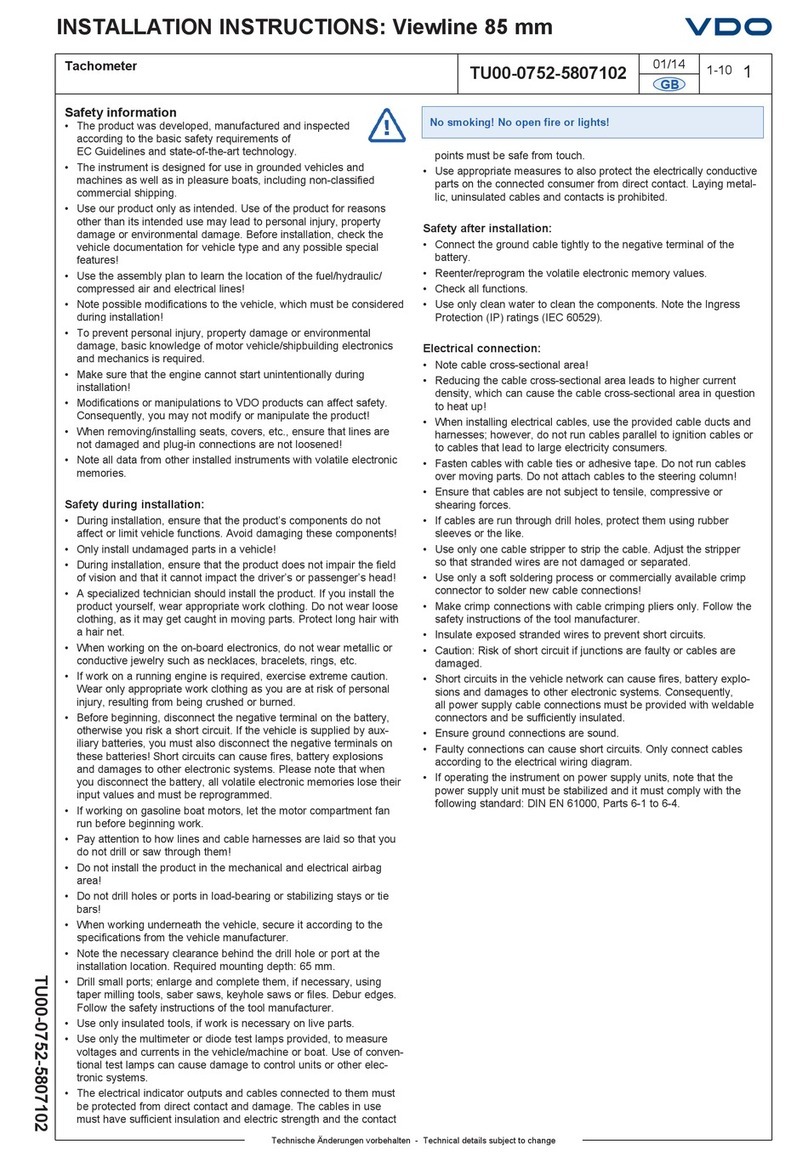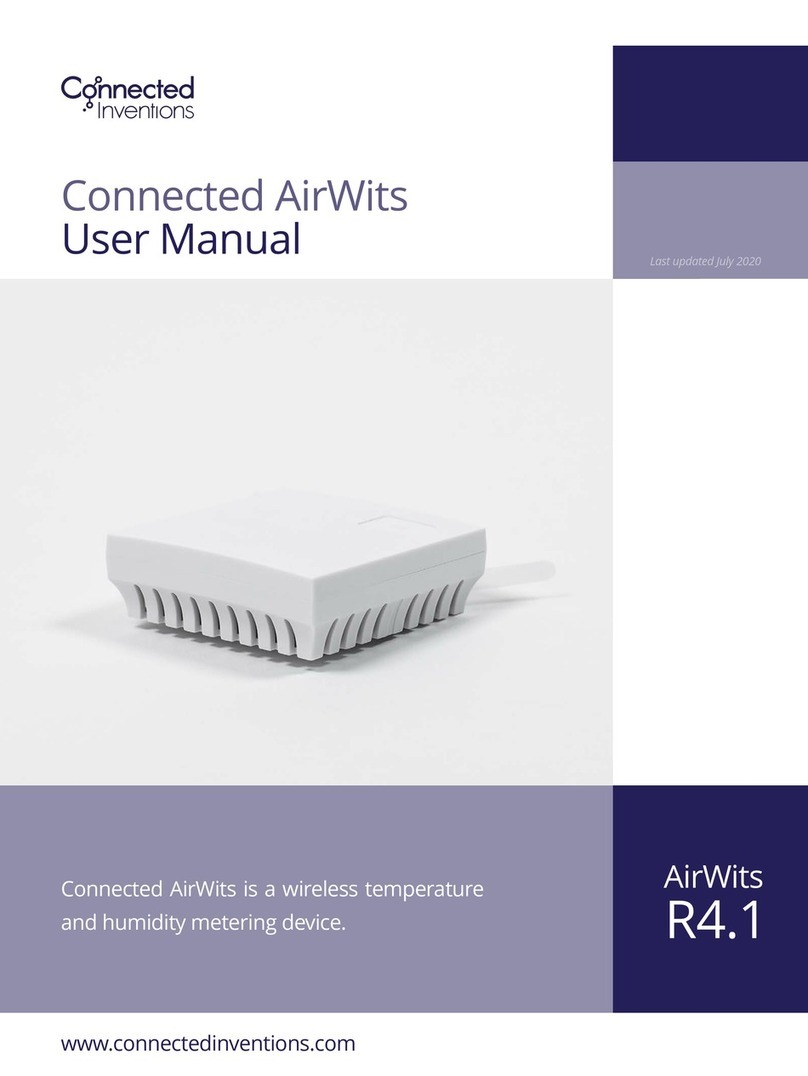Diesse MINI-CUBE User manual

USER MANUAL
Rev. 1.7 –May 2022
Automatic instrument for ESR determination
with modified Westergren method
Software version 1.xx
FOR IN VITRO DIAGNOSTIC USE ONLY

Rev. 1.7 (05.2022) MINI-CUBE | USER MANUAL 2
This page is intentionally left blank.

Rev. 1.7 (05.2022) MINI-CUBE | USER MANUAL 3
MINI-CUBE models:
This manual is applicable to the following MINI-CUBE instrument models:
Catalog number
Description
10392
MINI CUBE
MINI-CUBE Accessories:
Catalog number
Description
10435
ESR CONTROL CUBE 4 x 9 ml (2 x Level I + 2 x Level II)
10436
ESR CONTROL CUBE 2 x 9 ml (1 x Level I + 1 x Level II)
10293
Test device NEXT 500 (500 tests)
10294
Test device NEXT 1K (1000 tests)
10296
Test device NEXT 5K (5000 tests)
10297
Test device NEXT 10K (10000 tests)
21430440
Bluetooth Printer
10404
MINI-CUBE Thermal paper (for Bluetooth printer)
20550510
External barcode reader
30006190
MINI CUBE USB-to-Serial adapter

Rev. 1.7 (05.2022) MINI-CUBE | USER MANUAL 4
Manual revisions list:
MANUAL revisions
Description of changes
0 - 01/06/2016
Initial revision
1 - 01/10/2016
Chapter 3 composition of the instrument
1.1 - 25/01/2017
Modification of the list of manuals revision and drafting of the
document software revisions
1.2 - 22/02/2018
Edit description “Test Device NEXT”
1.3 - 20/06/2018
Modify of controls
1.4 - 31/07/2020
Addition of Intended Use, Updating Software and BD Microtainer®
MAP tubes paragraphs, update of WEEE and RAE normative
references, inserted QR code for connecting to host instructions
1.5 - 17/05/2021
Update of the manual with new logo and new graphic design with
updated brand colors
1.6 - 17/08/2021
Update of the manual following the latest FW release (V. 1.26).
Update of the screen with the new heading.
Adding of APPENDIX MINI-CUBE PRINTER TOOL II –MPT II
INSTALLATION GUIDE
1.7 –05/2022
Update of the intended purpose

Rev. 1.7 (05.2022) MINI-CUBE | USER MANUAL 5
Manufacturer
DIESSE DIAGNOSTICA SENESE SpA
Strada dei Laghi 39, 53035 Monteriggioni (SI) Italy
Tel. +39 0577 307109, Fax. + 39 0577 307106
www.diesse.it
TECHNICAL SUPPORT
Strada dei Laghi 39, 53035 Monteriggioni (SI) Italy
Tel. +39 0577 307109, Fax. + 39 0577 307106
Numero Verde: 800 606932
e-mail: technicalsupport@diesse.it
If any serious incident in relation to this device has occurred in the European Union
market territory, please report without delay to the manufacturer and competent
authority of your Member State.
No page in this manual may be reproduced in any form or by any means, electronic,
mechanical or otherwise, for any use whatsoever without prior written permission from
DIESSE Diagnostica Senese S.p.A.

Rev. 1.7 (05.2022) MINI-CUBE | USER MANUAL 6
Symbols:
Key of graphic symbols
Instrument meeting the requirements of the EC Directive 98/79 on in
vitro diagnostic medical devices.
In vitro diagnostic medical device
Manufacturing date
Serial number
Manufacturer
Key of electric and safety symbols
Protective conductor
WEEE: Waste electrical and electronic equipment –Separate Collection is
required pursuant to Legislative Decree No. 49 of March 14. 2014 (Italy), on
“implementation of Directive 2012/19/EC.”
Attention: please read this manual carefully and comply with the safety
symbols.
Caution: risk of electrical shock
Key of graphic symbols used in this document
WARNING: potential risk of personal injury; all the conditions indicated in
the relative text must be read and understood before proceeding.
CAUTION: potential risk of damage to the instrument; all the conditions
indicated in the relative text must be read and understood before
proceeding.
N.B. important information.
BIOHAZARD: risk of contamination with potentially infected substances.
Instrument that complies with MET standards for the Canadian and US
markets

Rev. 1.7 (05.2022) MINI-CUBE | USER MANUAL 7
LIMITATIONS AND WARNINGS
Before installation and use of the instrument, for proper and safe use, it is advisable to
carefully read the warnings and instructions in this user manual. It is important that this
user manual be kept together with the instrument for future reference.
In the event of sale or transfer, make sure that this manual accompanies the instrument
to allow new users to be informed about the instrument’s functions and the related
warnings.
It is recommended to allow only qualified and skilled laboratory personnel to use the
instrument.
The safety and performance requirements of the instrument can no longer
be guaranteed when the instrument is powered using a different cable from
the one supplied, compatible with the power supply of the country of
installation.
BIO-CONTAMINATION HAZARDS
When an analysis system like the MINI-CUBE is used, all precautions must be
taken regarding biological risks. The samples do not require preparation. The
samples must be disposed of in accordance with laboratory instructions and
with local laws.
Observe personal and group safety measures foreseen for the operator and
appropriate for the work environment. Comply with directives on safety and
with applicable laws.
In the case of leakage of biological material, during the working cycle, clean
external surfaces of the instrument using appropriate personal protective
equipment and observe regulations on sanitization.
All supplied materials must be disposed of in accordance with local laws.

Rev. 1.7 (05.2022) MINI-CUBE | USER MANUAL 8
Content
1INTRODUCTION..............................................................................................................................................................10
1.1 Intended purpose............................................................................................................................................10
1.2 Presentation of the instrument.........................................................................................................10
1.3 Clinical significance of ESR.................................................................................................................... 11
1.4 Normal ESR values (Westergren citrated).................................................................................. 12
1.5 Materials required for use of the instrument............................................................................ 12
1.6 Precautions..................................................................................................................................................... 12
1.7 Maintenance procedure......................................................................................................................... 13
1.8 External cleaning of the instrument............................................................................................... 13
2TECHNICAL DATA..........................................................................................................................................................14
2.1 Technical description ...............................................................................................................................14
2.2 External connections of the instrument...................................................................................... 15
2.3 Updating software...................................................................................................................................... 15
2.4 Technical features.......................................................................................................................................16
2.5 Unit of measure............................................................................................................................................16
3INSTALLATION.................................................................................................................................................................17
3.1 Transport and handling .......................................................................................................................... 17
3.2 Packaging characteristics ..................................................................................................................... 17
3.3 Materials provided...................................................................................................................................... 17
3.4 Unpacking the instrument...................................................................................................................18
3.5 Setup...................................................................................................................................................................19
3.6 Installation procedure.............................................................................................................................20
3.7 Limitations and warnings.....................................................................................................................20
3.8 Composition of the instrument........................................................................................................20
3.9 Disposal............................................................................................................................................................. 21
4USE.........................................................................................................................................................................................22
4.1 Instructions for the operator............................................................................................................... 22
4.2 Compatible test tubes ............................................................................................................................ 22

Rev. 1.7 (05.2022) MINI-CUBE | USER MANUAL 9
4.3 Sample requirements ............................................................................................................................. 22
4.4 Preparation of the sample ................................................................................................................... 22
4.5 Test tube labelling..................................................................................................................................... 22
4.6 MAP test tube labeling........................................................................................................................... 23
4.7Description of the MINI-CUBE menu............................................................................................24
4.7.1 Home........................................................................................................................................................24
4.7.2 Performing an analysis..................................................................................................................24
4.7.3 Inserting the test tubes.................................................................................................................26
4.7.4 Starting the analysis cycle...........................................................................................................28
4.7.5 Archive.....................................................................................................................................................29
4.7.6 Settings ...................................................................................................................................................34
5QUALITY CONTROL.....................................................................................................................................................37
5.1 Performing QC analysis .........................................................................................................................40
6TROUBLESHOOTING...................................................................................................................................................41
6.1 Measuring abnormal samples...........................................................................................................43
7CALCULATING THE DAS 28...................................................................................................................................44
7.1 Clinical significance of Rheumatoid Arthritis...........................................................................44
7.2 The importance of early diagnosis..................................................................................................44
7.3 Das 28................................................................................................................................................................46
8CONNECTION TO A HOST COMPUTER...........................................................................................................51
9APPENDIX: MINI-CUBE PRINTER TOOL II –MPT II INSTALLATION GUIDE.............................53
10 BIBLIOGRAPHY..............................................................................................................................................................54

Rev. 1.7 (05.2022) MINI-CUBE | USER MANUAL 10
1INTRODUCTION
1.1 Intended purpose
The MINI-CUBE is an automated instrument for the quantitative Erythrocyte
Sedimentation Rate (ESR) determination, measured using modified Westergren
method on venous and capillary whole blood anticoagulated with K2EDTA or K3EDTA.
ESR is a non-specific parameter of an inflammatory status, used as an aid for the
monitoring of the physiological or pathological state of the patient.
The instrument is to be used only by professional laboratory users.
1.2 Presentation of the instrument
The MINI-CUBE (Figure 1.1) is an automated instrument designed to measure the
erythrocyte sedimentation rate (ESR) of blood samples anti-coagulated with EDTA,
directly from the EDTA tube. The instrument analyzes four blood samples
simultaneously on a random access and continual loading basis. The color touch screen
allows the user to select various instrument functions which are described in more detail
in the following sections. ESR results, obtained in only 20 minutes, show excellent
correlation to the Westergren Reference method at one hour (ref. 1.4).
Figure 1.1
The instrument is designed with the temperature correction always activated and
relates the results to a temperature of 18°C according to Manley’s Normogram (Figure
1.2). However, it is possible to de-select the temperature correction for individual
laboratory needs.

Rev. 1.7 (05.2022) MINI-CUBE | USER MANUAL 11
Figure 1.2: Manley's Normogram
1.3 Clinical significance of ESR
The erythrocyte sedimentation rate measures the distance travelled by red blood cells
in autologous plasma for a certain period of time. In normal conditions, red blood cells
tend to reciprocally move apart due to the presence of negative electric loads from the
numerous residues of sialic acid present at a membrane glycoprotein level. When the
protein composition of plasma changes with the production of “acute phase proteins”
at hepatic level, following an inflammatory process or tissue damage, the bond of these
proteins (fibrinogen, immunoglobulins) with the surface of the red blood cells, changes
the membrane potential negative load (Z) and the red blood cells can bind, forming a
rouleaux formation. These rouleauxed cells aggregate to form microspheres of a uniform
radius which sediment as their density exceeds that of plasma. The ESR value increases
in all conditions with increased acute phase proteins, particularly fibrinogen which is
considered to account for 70% of the sedimentation phenomenon, and increased
immunoglobulins observed with oncological/haematological diseases and acute
infections. The ESR is therefore a non-specific measurement of an inflammatory state;
the rate is high in numerous, different pathological conditions such as inflammatory
diseases (infections, rheumatic diseases), a relative/absolute increase in globulins
(nephrotic syndrome, myeloma), tissue necrosis (myocardial infarction, tumours).
Literature suggests the ESR is useful in diagnosing some diseases, such as polymyalgia
rheumatica, temporal arteritis, rheumatoid arthritis and Hodgkin’s disease, and is useful
as an effective marker of pharmacological treatment in some diseases including
rheumatoid arthritis, vasculitis, collagenosis and septic arthritis. The ESR in usually

Rev. 1.7 (05.2022) MINI-CUBE | USER MANUAL 12
higher in females compared to males and increases in pregnancy and tends to rise with
age in both genders.
1.4 Normal ESR values (Westergren citrated)
With the Westergren reference method, the test is performed on blood diluted in citrate;
with four parts blood to one part anti-coagulant. The diluted blood is then aspirated in a
special, graduated, 2.5 mm diameter pipette which is kept upright. The erythrocyte
sedimentation level is recorded after one hour, measuring the distance between the
lower side of the plasma meniscus to the top layer of sedimented red blood cells.
Guidelines for ESR Reference Values for the Westergren ESR Method* are as follows:
Normal 0-20mm/hr
* Follow CLSI Procedures for the Erythrocyte Sedimentation Rate Test; Approved
Standard. CLSI document H02.
Reference values should be established locally in accordance with the individual
laboratory’s accrediting agencies. Refer to CLSI document H02 for age and gender-
specific reference values.
1.5 Materials required for use of the instrument
Exclusively use the materials of the MINI-CUBE line manufactured by DIESSE
DIAGNOSTICA SENESE S.p.A. (Always read the instructions for use that accompany each
product before operating); any other part or accessory used in the instrument may cause
damage or incorrect results. The manufacturer therefore declines all responsibility for
damages deriving from inappropriate use.
1.6 Precautions
The MINI-CUBE system offers a closed tube system which provides less exposure
to potentially infectious samples; however, all necessary precautions and
personal protective equipment for handling biological material apply. Waste material
should be disposed of in accordance with your local waste requirements.

Rev. 1.7 (05.2022) MINI-CUBE | USER MANUAL 13
1.7 Maintenance procedure
The MINI-CUBE is designed to require minimal maintenance.
For any type of maintenance activity:
•Switch-off the instrument and disconnect from the power source.
•Use all appropriate personal protective equipment (gloves) during
operation.
In the event of biological material leakage, wipe the outer surfaces of the
instrument with 70% isopropyl alcohol and immediately contact Technical
Services.
Note: it is advisable not to leave the instrument turned on all the time but to switch it off
and on at least once a week
1.8 External cleaning of the instrument
External cleaning is required for safety reasons.
Decontamination procedure:
1. With the instrument turned off, clean with liquid detergent and leave to
dry.
2. Repeat the operation with 70% isopropyl alcohol.
3. Leave the instrument turned off for at least 1 hour before starting a new
operating cycle or carrying out any other operation on the instrument.
Do not attempt to remove any of the screws or open the instrument and/or clean the
interior. Please contact Technical Services for further instruction.

Rev. 1.7 (05.2022) MINI-CUBE | USER MANUAL 14
2TECHNICAL DATA
2.1 Technical description
Figure 2.1
The MINI-CUBE module consists of a single body containing all the operating functions
necessary for analyzing the sample.
Reading unit
The motor lifts the reading unit which utilizes four optical sensors (one per position) to
verify the suitability of the sample and detect the level at baseline and level after 20
minutes of sedimentation.
Detection of the sample
The optical sensor of each position scans the inserted test tube, checking that it contains
an adequate volume of blood and identifying the type of tube (13x75 mm EDTA tube, BD
Microtainer® or BD Microtainer® MAP or Greiner MiniCollect® or Sarstedt Microvette®
APT EDTA tubes).
Alarm
The function of the alarm is to alert the operator during various stages of the operating
cycle or in the event of errors.

Rev. 1.7 (05.2022) MINI-CUBE | USER MANUAL 15
Identification of the sample
The sample is identified by an external bar code reader (optional accessory). The patient
ID code can also be manually entered using a stylus on the keypad display.
2.2 External connections of the instrument
The MINI-CUBE has a Bluetooth 4.0 connection for an external printer (optional
accessory) or for connection to a mobile device.
The power supply, serial/USB port for connection to the computer, a USB port for
connection to the USB mass storage device that can be used to update software or
export files and port for the external bar code reader are positioned at the rear of the
instrument. The functional units of the module are described below.
Figure 2.2
2.3 Updating software
Updating software is a simple, direct procedure:
•Save the new software (i.e.
mcfw.bin
file and
System
folder) into a USB mass storage
device
•With the instrument switched off, insert the USB device into the appropriate port
(Errore. L'origine riferimento non è stata trovata.)
Figure 2.3

Rev. 1.7 (05.2022) MINI-CUBE | USER MANUAL 16
Power on the instrument and wait for a few seconds. The instrument will update
automatically.
Software revisions history is available on DIESSE’s website:
https://www.diesse.it/en/download/id:21651/
2.4 Technical features
USE
Internal use
POWER SUPPLY
Input: 100-240 Vac, 50-60Hz, 0.5A
Output: 9Vdc@2A marked UL
LPS, DC output shall be provided a reinforced
insulation between primary and secondary circuits
DIMENSIONS (mm)
135x191x125
WEIGHT
1.5 kg (3.31 lbs)
ROOM TEMPERATURE
Operating temperature From +15° to +35°C
Storage temperature From +5° to +45°C
RELATIVE HUMIDITY
(RH)
20%-80% without condensation
ALTITUDE
Maximum 2000 meters (6562 ft)
NOISE LEVEL
below 80 decibel
LEVEL OF POLLUTION
2 pollution degrees
MEASUREMENT
RANGE
4 ml Tube: 1 - 140 mm/hr
Pediatric Tube: 1 –60 mm/hr
CENTRAL UNIT
ARM Cortex-M4 180 MHz Microprocessor
DISPLAY
480x272 TFT 16.7 Million colors+ Resistive Touch Panel
OPTICAL UNIT
4 pairs of optical elements (photodiode +
phototransistor)
INTERFACES
USB
2.5 Unit of measure
The units of measure are expressed according to the INTERNATIONAL MEASURING
SYSTEM as indicated in the technical standard CEI EN ISO 80000-1:2013.

Rev. 1.7 (05.2022) MINI-CUBE | USER MANUAL 17
3INSTALLATION
The MINI-CUBE is a precision instrument and must be handled with appropriate
care and precautions. Inappropriate operations may damage the internal
optoelectronic components and cause mechanical damage. Follow the
instructions in this chapter in order to ensure proper operation of the instrument and safety
of the operator.
3.1 Transport and handling
The instrument must be transported and handled in its original packaging.
Do not leave the packed instrument in a damp environment or allow the
boxed package to get wet. If the instrument has been subjected to temperature
conditions below 10°C for more than 24 hours, allow the instrument to sit at room
temperature for one hour prior to installing/powering on.
3.2 Packaging characteristics
The instrument is packed in:
1. An external cardboard box
2. Moulded housing in CFC and HCFC-free expanded, closed cell polyethylene.
Box Dimensions
33 x 23 x 15
cm
1.5
Kg
Save the original packaging including the internal parts.
3.3 Materials provided
The MINI-CUBE is supplied with the following materials:
•User Manual.
•USB mass storage with multi-lingual manual.
•Non-capacitive touch stylus.
•DC power Supply (see characteristics in Technical Features section).

Rev. 1.7 (05.2022) MINI-CUBE | USER MANUAL 18
•One power cable for each module according to IEC International Standards
(Female Plug IEC 320 C-13; Male Plug Schuko EEC 7-VII; Rating: 10A / 250V AC).
•USB cable.
•Certificate of Analysis.
•Packing list.
Figure 3.1
3.4 Unpacking the instrument
1. Open the box from the top (see the packing labels) and remove the accessories
Figure 3.2
2. Remove the instrument and power supply unit from the box

Rev. 1.7 (05.2022) MINI-CUBE | USER MANUAL 19
3. Remove the expanded polyethylene blocks containing the instrument and
power supply unit
Figure 3.3
4. Remove the protective pack from the instrument
5. Verify the materials supplied against the packing list
3.5 Setup
For normal safety requirements and given the type of examination it performs, the
instrument must be positioned away from heat sources, in areas unreachable by liquids
and in a dust-free environment. Position the instrument on a solid perfectly level bench,
not subject to shaking or vibrations. The 15 cm or 6” perimeter distance as indicated in
the Figure 3.4 must be observed as a safety precaution.
Figure 3.4
It is advisable to position the instrument to 1 meter from devices that generate
electromagnetic waves (e.g. laboratory fridges, centrifuges) and instruments that do not
have CE marking.

Rev. 1.7 (05.2022) MINI-CUBE | USER MANUAL 20
The safety of the instrument and of the operator is not guaranteed if one or more of the
following conditions are violated:
•The main power source must be compatible with the voltage and current
specifications indicated on the back of the instrument.
•Before connecting any non-Diesse external accessories (i.e. barcode reader,
printer, USB drive), check the compatibility.
3.6 Installation procedure
Only use the power supply unit provided:
1. Position the instrument on a solid surface
2. After checking that the power switch is in the “OFF” position,
connect the power supply unit plug provided with the instrument.
3. Connect the power supply unit cable to the main power source.
4. Optional - connect the barcode scanner and Bluetooth printer. Once
the MINI-CUBE is powered on, a series of beeps will be heard indicating that
the system recognized the scanner. Follow the printer installation steps in
chapter 4 to enable the printer.
3.7 Limitations and warnings
IN CASE OF FIRE OR GENERAL DANGER, TURN OFF THE INSTRUMENT AND UNPLUG
THE POWER CABLE.
3.8 Composition of the instrument
The instrument is made up of the following materials, expressed in percentages:
Material
%
IRON
10
COPPER
3
ALUMINIUM
60
PLASTIC MATERIALS (PVC, ABS...)
20
SILICON
2
Gold
0,1
Tantalum
0,2
Cadmium
0,2
Others (No Latex)
4,5
Other manuals for MINI-CUBE
4
This manual suits for next models
1
Table of contents
Other Diesse Measuring Instrument manuals
Popular Measuring Instrument manuals by other brands
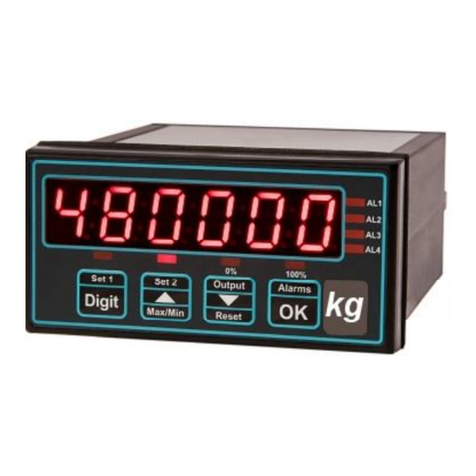
London Electronics
London Electronics IL2-L Connection details, scaling and general information
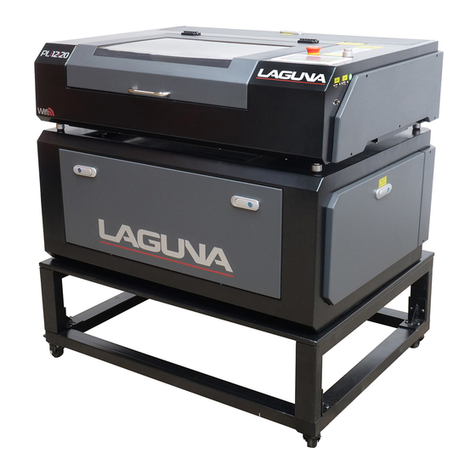
Laguna Tools
Laguna Tools PL1220 owner's manual

Pfeiffer Vacuum
Pfeiffer Vacuum PPT 200 operating instructions
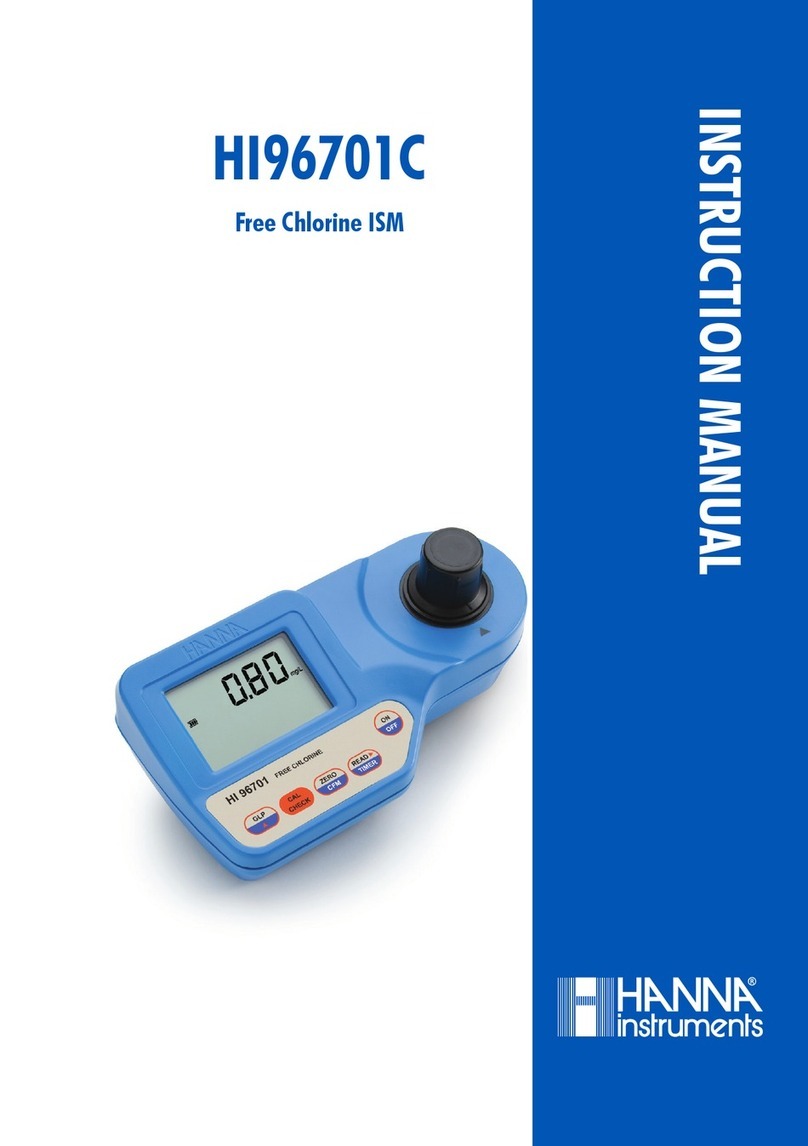
Hanna Instruments
Hanna Instruments HI 96701C instruction manual
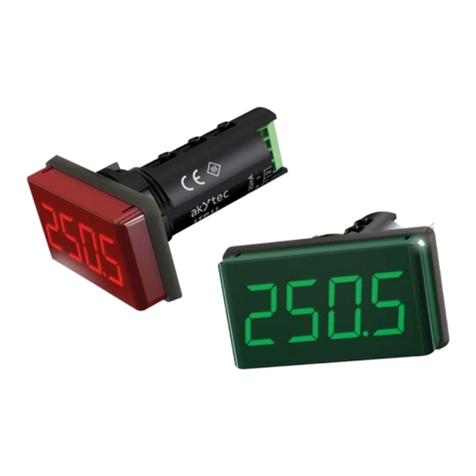
Akytec
Akytec ITP11 user guide
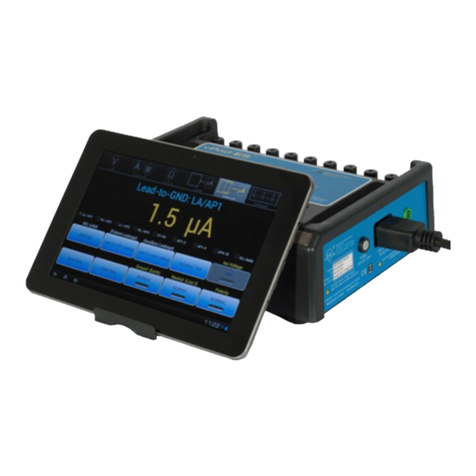
DATREND Systems
DATREND Systems Vision Pad quick start guide
